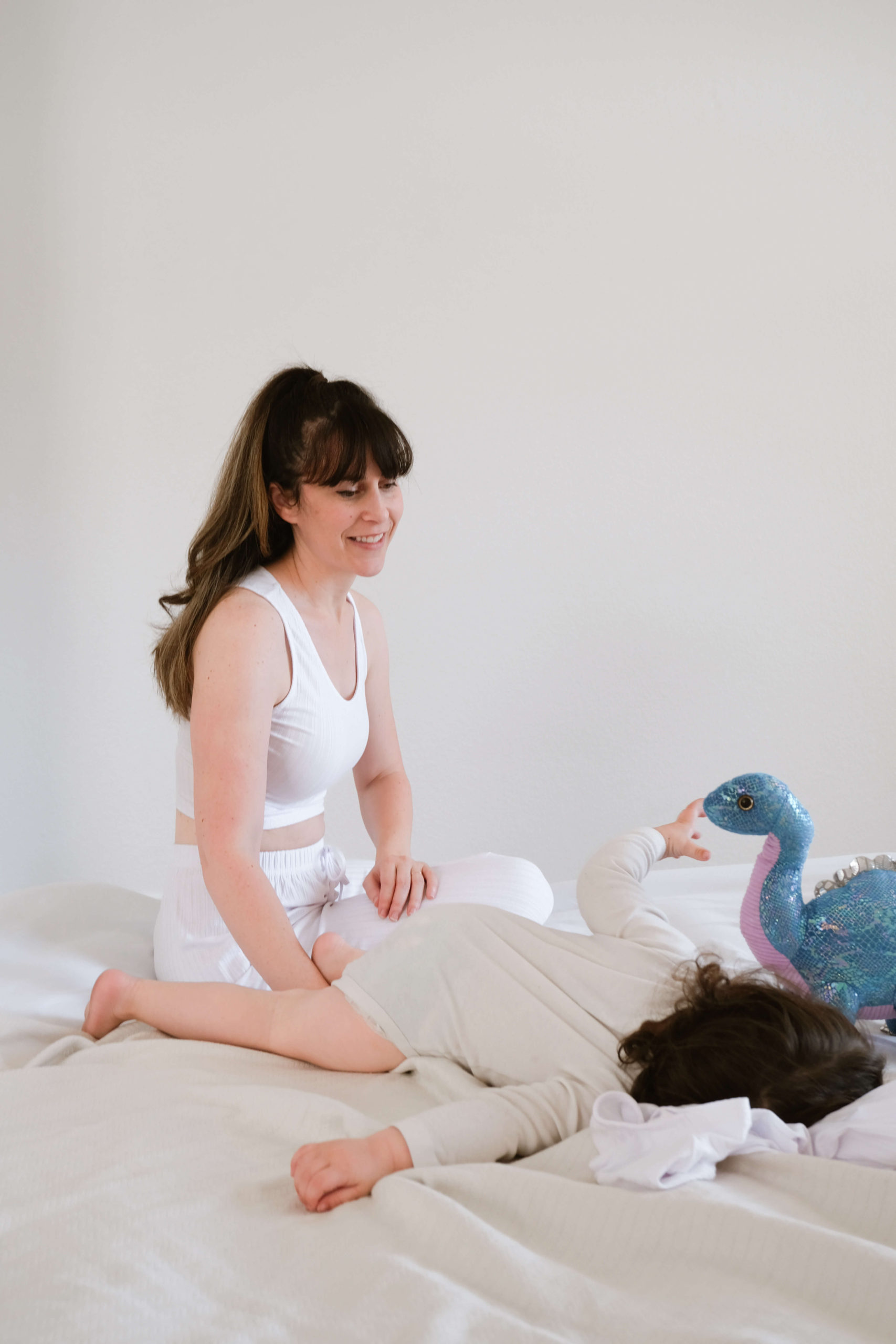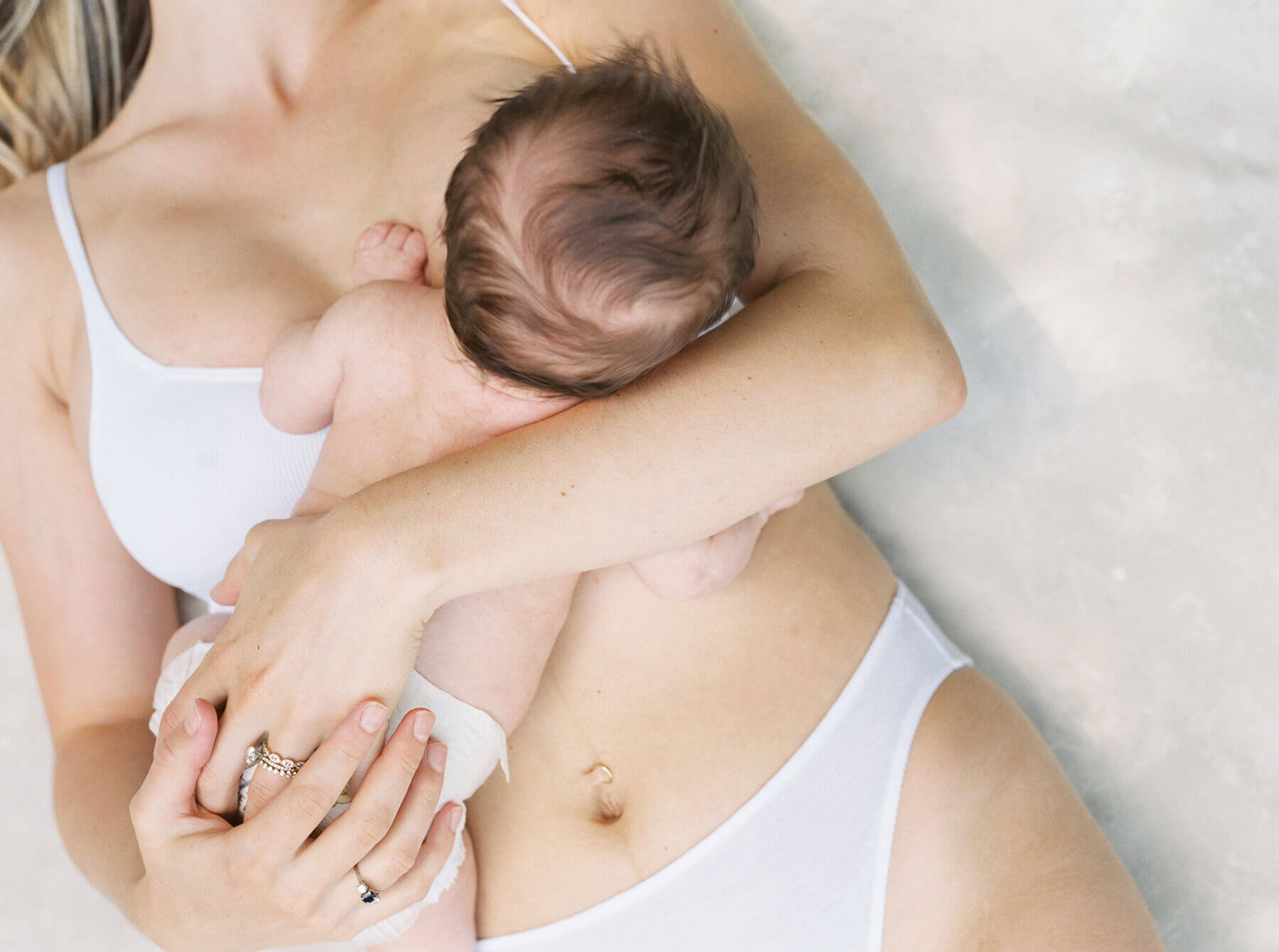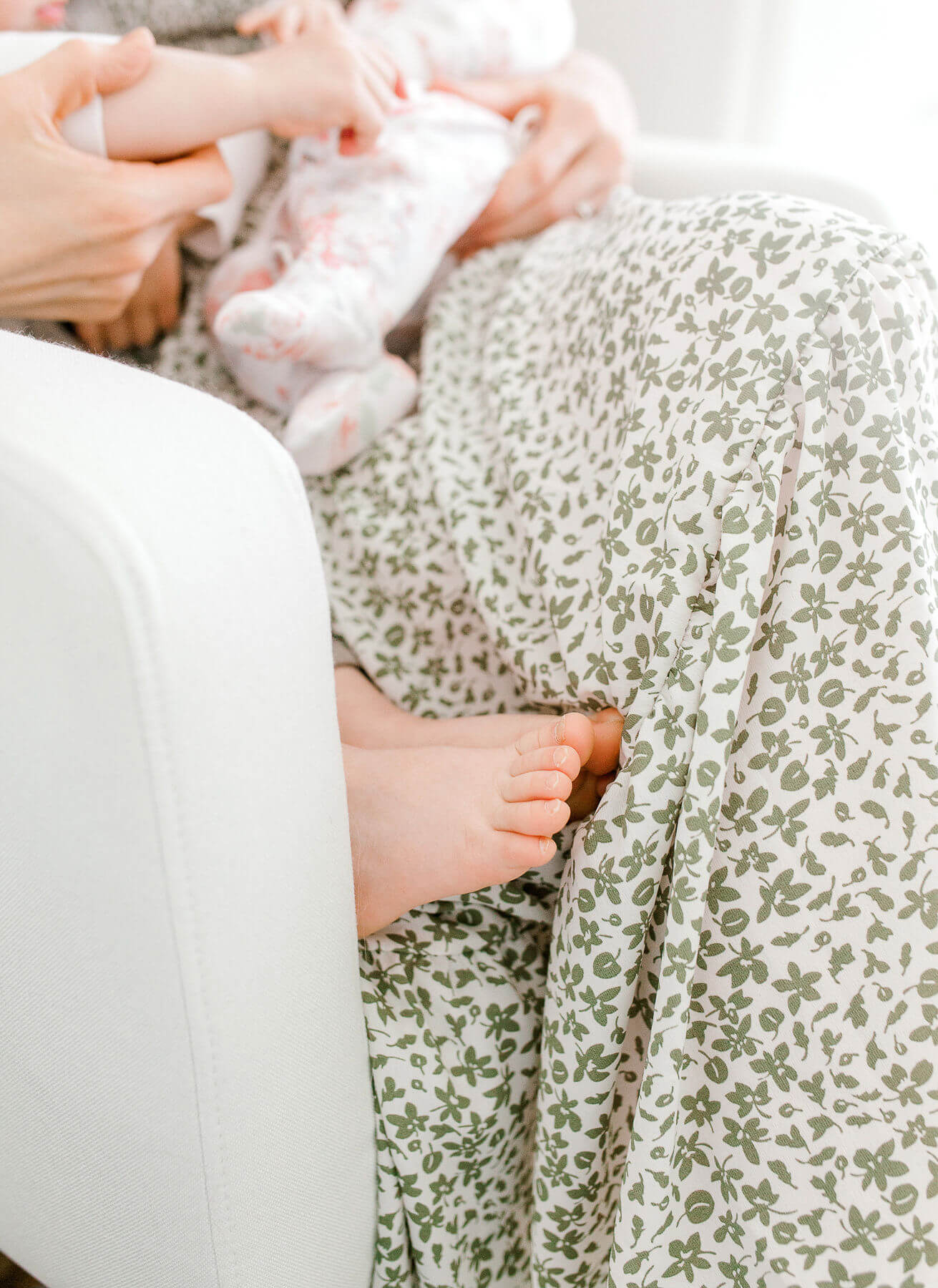I used to panic when I woke up to my baby sleeping on his side or tummy. I knew that back-sleeping is vital to safe bedsharing, and I drowned in mom guilt. But the more I read about biologically normal infant sleep, I realized this was going to keep happening, and there was only one thing I could do.
If your baby is younger than twelve months old, any time you notice them sleeping on their side or tummy, adjust them so that they are on their back. Remind yourself why sleeping on their back is critical to their safety, but then give yourself grace. You are doing the only thing you can.
The science of how back-sleeping protects infants from Sudden Infant Death Syndrome is compelling. It demonstrates why it’s worth the effort to move them onto their back each and every time you find them sleeping on their side or tummy, until they reach their first birthday.


loungewear | dinosaur stuffie (similar)
Three Dangerous Risks If Your Baby Is Not On Their Back
- Very young babies have a hard time expanding their lungs all the way when they sleep prone (i.e. on their front/tummy.) The position compresses their lungs, and it’s believed to be a cause of SIDS.
- Infants are at risk of lethal re-breathing of carbon dioxide that’s trapped in bedding as they sleep prone. If your baby’s face is near a thick blanket or the top you’re wearing to stay warm, carbon dioxide can get trapped in the fabric. Your baby will inhale too much and will not get enough new, fresh oxygen.
- When babies sleep prone, arousal deficiency appears to play a role in SIDS. This is very important. We humans sleep in deeper sleep when we’re prone (i.e. face-down on the stomach). It is harder to wake up from a deep sleep than a light sleep.
Pro tip — Here’s a thin blanket and a cardigan that I use to cosleep. Remember, the thinner and more breathable the fabric, the better.
Babies who are able to wake themselves up easier and more often throughout the night appear to be safer against SIDS.
Arousal can be a protective response to dangerous conditions or events in sleep. Observations in victims of SIDS support a role of arousal deficiency in SIDS.
Infants who subsequently died of SIDS were found to move less in sleep, and parents of SIDS victims reported retrospectively greater difficulty awakening their infants and fewer infant body movements than reported by the parents of healthy infants.
James McKenna, Ph.D.
Dangerous conditions in sleep could be your baby overheating or breathing in too much carbon dioxide. In that case, they need to wake themselves up quickly and signal to you that they need help.
If they’re having a hard time waking themselves up, it could quickly escalate into a very dangerous or fatal situation.
The One Thing You Can Do If You Notice Your Baby Is Not On Their Back
What you should do, anytime before your baby dives into their first smash cake is: Move them so that they are on their back.
I see you rolling your eyes!
I acknowledge that this is frustrating advice when you’re running on fumes and your baby has finally fallen asleep. And you worry that if you move or shift them, they’re going to wake up.
But if you do this consistently, over time your baby will get used to your hands gently shifting them as they sleep. It may take a few weeks, but if you commit to it — your baby will get used to it and stop waking up.
What about that thing you heard on TikTok?
You may have heard the adage: “When a baby can roll from front-to-back and back-to-front, they can safely sleep on their tummy.”
I’ve heard that, too. The thing is, it’s referring to a baby sleeping alone on a crib mattress.
It does not apply to a baby sleeping beside their parent(s) on an adult mattress.
Remember: Even the most firm adult mattress on the market is not as firm as a crib mattress.
Why a Bedsharing Baby May Not Want to Sleep On Their Back
It is completely natural and so common for babies to want to sleep on their side. They want to be right there next to your breast, so that they can nurse on and off throughout the night.
That’s where the action is! That is their happy place. They don’t wanna go to their back. They wanna be right there the whole time. So know that you’re not doing anything wrong.
That’s just where they wanna be.
And babies commonly roll onto their tummy throughout the night after they learn to roll over. When they learn how to crawl or roll, that’s what they want to do — all the time. They want to move around and wiggle, test their new skills that they’re learning.
And many of them will find out that they are more comfortable on their tummy.
So remember that babies often want to sleep on their tummy, and give yourself a pat on the back — because if they were in another room in a crib and they went to their tummy and something went wrong, you might not know about it in time.
But you’re only inches away when you’re bedsharing.
So at least you’re right there, facing them as you lie in the cuddle curl position. And as a breastfeeding mom, you’re biologically in-tune with them. In Safe Infant Sleep, Dr. James McKenna describes mothers waking up when they somehow sensed their infant overheating, experiencing apnea, and so on.
The mother-child dyad is a wondrous thing.
If you’re having a hard time sleeping in the cuddle curl because it’s too painful, my Cuddle Curl FAQ guide will help you prevent pain at night and relieve it in the morning. Read through the 5-star reviews from other bedsharing moms!
Why a Bedsharing Baby May Not Be Able to Sleep On Their Back
Brittni Mella Cepeda, holistic infant sleep specialist and founder of Resting in Motherhood, says it is a red flag if a baby wakes up every single time you lay them down on their back. This may indicate that they cannot sleep on their back.
Common causes of a baby not being able to sleep on their back are:
- Restricted tongue function
- An obstructed airway caused by enlarged adenoids and/or a tongue tie
- Reflux
- Muscle tightness
What should you do if your baby is exhibiting some of these signs?
Brittni suggests doing some investigating. If your baby snores or sleeps with their mouth open, you’ll want to look into airway health. You should consult a pediatric dentist or an airway health specialist.
If you think your baby has reflux, get to the root cause (commonly swallowed air from improper tongue function and/or food intolerances).
If you think your baby has tight muscles, you can consult a trusted baby chiropractor.
Should You Bedshare With a Baby Who Doesn’t Like to Sleep on Their Back?
Something you may have noticed about bedsharing is that ultimately you have to make the call.
The experts can cite their research papers and the studies they conducted in their sleep laboratories all day long.
They’ve made plenty of scientifically-backed recommendations for you to consider.
But they’re not there with you at 2 o’clock in the morning when you wake up and find baby on her tummy (again).
You are the only person who will know if your baby is safe beside you in bed.
Ultimately, you will have to look at the research and listen to your intuition.
Follow your head and your heart. Trust yourself.
And then make the call.
Disclaimer: If you make a purchase through an affiliate link, I may receive a small commission at no additional cost to you.






[…] As your baby grows, nighttime wriggling will become the norm. Once they can roll onto their tummy, many babies will prefer to sleep in that position. […]
[…] I detach baby from my breast and gently move him from his side to his back. […]
[…] you want to try this position, pull baby close to your breasts after they’ve rolled onto their back. Then stretch out your arm, and place your hand on the mattress on the other side of their […]